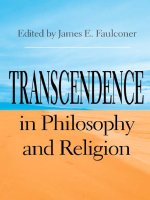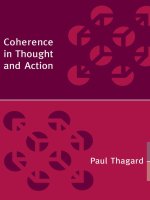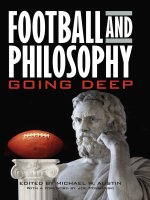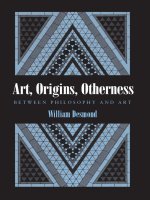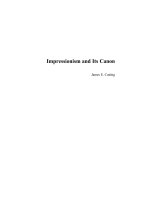indiana university press transcendence in philosophy and religion jun 2003
Bạn đang xem bản rút gọn của tài liệu. Xem và tải ngay bản đầy đủ của tài liệu tại đây (548.11 KB, 162 trang )
Transcendence in
Philosophy and Religion
Indiana Series in the Philosophy of Religion
Merold Westphal, general editor
Transcendence in
Philosophy and
Religion
Edited by
James E. Faulconer
Indiana University Press
Bloomington and Indianapolis
This book is a publication of
Indiana University Press
601 North Morton Street
Bloomington, IN 47404-3797 USA
/>≈
iupress
Telephone orders 800-842-6796
Fax orders 812-855-7931
Orders by e-mail
∫ 2003 by Indiana University Press
All rights reserved
No part of this book may be reproduced or utilized in any form or
by any means, electronic or mechanical, including photocopying
and recording, or by any information storage and retrieval system,
without permission in writing from the publisher. The Association
of American University Presses’ Resolution on Permissions
constitutes the only exception to this prohibition.
The paper used in this publication meets the minimum require-
ments of American National Standard for Information Sciences—
Permanence of Paper for Printed Library Materials, ANSI
Z39.48-1984.
Manufactured in the United States of America
Library of Congress Cataloging-in-Publication Data
Transcendence in philosophy and religion / edited by James E. Faulconer.
p. cm. — (Indiana series in the philosophy of religion)
Includes bibliographical references and index.
ISBN 0-253-34199-X (alk. paper) — ISBN 0-253-21575-7 (pbk. : alk. paper)
1. Philosophy and religion. 2. Transcendence (Philosophy) 3. Hermeneutics.
I. Faulconer, James E. II. Series.
B56 .T73 2003
111%.6—dc21
2002012401
1 2 3 4 5 08 07 06 05 04 03
v
Contents
acknowledgments / vii
Introduction: Thinking Transcendence
James E. Faulconer / 1
PART I. HERMENEUTICS AND PHILOSOPHICAL REFLECTION
1. Whose Philosophy? Which Religion? Reflections on Reason as Faith
Merold Westphal / 13
2. The Question into Meaning and the Question of God:
A Hermeneutic Approach
Ben Vedder / 35
3. The Sense of Symbols as the Core of Religion:
A Philosophical Approach to a Theological Debate
Paul Moyaert / 53
4. Philosophy and Transcendence: Religion and the Possibility of Justice
James E. Faulconer / 70
PART II. RETHINKING PHENOMENOLOGY FROM RELIGION
5. The Event, the Phenomenon, and the Revealed
Jean-Luc Marion / 87
6. Phenomenality and Transcendence
Marlène Zarader / 106
7. Transcendence and the Hermeneutic Circle:
Some Thoughts on Marion and Heidegger
Béatrice Han / 120
contributors / 145
index / 147
acknowledgments
My thanks to Brigham Young University for the leave during which I
compiled these essays and to the many people, past and present, who have
helped me with advice and criticism. I am especially grateful to my wife,
Janice K. Faulconer, for her support and encouragement.
Transcendence in
Philosophy and Religion
1
Introduction
Thinking Transcendence
James E. Faulconer
Since Kant, we have been faced with the question of how to think tran-
scendence. Until the modern period, philosophy and religion were generally
content to think transcendence without thinking the problematic of transcen-
dence. Of course, the question of how to think the Divine was a perennial
problem, but in a way quite different than it becomes with Hume and then
Kant. The question was how to do so, not whether one could. However, with
Critique of Pure Reason, all questions of transcendence are put outside the
realm of objective thought. As Paul Ricoeur reminds us, that does not mean
that rational theology comes to an end (Le mal 30). The work of theological
thinkers deeply indebted to Kant, such as Fichte, Schelling, and Hegel, is evi-
dence against any such claim, though the question to which they respond,
‘‘How are we to think transcendence or what is transcendent?’’ remains. A
response to that question becomes the heart of any philosophical theology. But
the question of transcendence is not relevant only to theology, philosophical
or otherwise.
Though seldom noticed in the English-speaking philosophical world, as
Vincent Descombes has shown, from Alexandre Kojeve on, French philosophy
James E. Faulconer
2
has been concerned with the question of transcendence: How is it possible for
there to be a relation to that which is, and remains, truly other? The work of
thinkers like Emmanuel Levinas, on the one hand, and Jacques Derrida, on the
other, has been taken up—though, in the Anglo-American world, more often by
those in literature than in philosophy. But until recently few on this side of the
Atlantic Ocean seem to have noticed that the question of transcendence is at
the heart of that work. Perhaps it is not too much to suggest that the 1961
publication of Levinas’s Totality and Infinity was especially important to mak-
ing the question explicit. But Totality and Infinity is important not only because
it makes the question of transcendence explicit but because, in doing so, it uses
the language and concepts of religion, within philosophy, to talk about tran-
scendence. Levinas explicitly wants to avoid confusing faith and philosophy.
1
Nevertheless, he does not hesitate to speak of God.
2
For Levinas, to speak of
transcendence philosophically is to have what one says informed by an under-
standing with its roots in religion, even if that speaking is not itself religious.
After Levinas, others take a similar approach—thinkers such as Jean-
François Courtine, Jean-Louis Chrétien, Michel Henry, Jean-Luc Marion,
and (perhaps) Paul Ricoeur. Though the number of works produced by those
thinkers is impressive, they have not been without their critics. In particular,
there has been something like an ongoing discussion between Dominique
Janicaud and those whom he criticizes, especially Marion and Henry, for
whom Christianity offers an alternative way of thinking about phenomena.
3
Though both Marion and Henry deny that they are theologizing phenomenol-
ogy,
4
Janicaud argues that what he calls ‘‘the theological turn’’ of French
phenomenology—in other words, the turn toward the Other, the invisible,
pure givenness, the Archi-Revelation, and so on—is a mistake and a departure
from phenomenology to theology.
5
Like Levinas, some of those whom Jan-
icaud criticizes are open about the fact that they see religion as offering new
ways to think about the problem of transcendence in philosophy in its various
manifestations. Nevertheless, they deny that they have ceased to do phenome-
nology or that they are doing theology. As the discussion between the two sides
shows, the question of transcendence is alive and well in Paris.
There are a variety of ways of responding to the question of transcendence,
but among those who believe that there are ways of doing so philosophically
and not only theologically, there are two primary, related camps. One group
can be said, roughly, to take a position similar to Ricoeur’s: philosophy cannot
decide whether the signs of religion point to some transcendent being, at least
partly because philosophy is primarily an epistemological enterprise and reli-
gion is not.
6
But that does not mean that we cannot make a philosophical
analysis of religious phenomena. Phenomenological analysis of religion is
possible, but phenomenology is condemned ‘‘to run the gauntlet of a herme-
neutic and precisely of a textual or scriptural hermeneutic’’ (Ricoeur, ‘‘Expéri-
ence’’ 130 [19]) in order to philosophize about religious things, including
Thinking Transcendence
3
transcendence. Neither does the inability of philosophy to decide whether
religion points to a transcendent being mean that religious thinking is irrele-
vant to or contradictory of philosophical and, specifically, phenomenological
thought. The necessity of always beginning from a set of presuppositions
means that the presuppositions of religion may be relevant to philosophical
thought and that the analysis of religious phenomena may shed light on other
phenomena.
The first two essays of this volume, those by Merold Westphal and Ben
Vedder, both argue for the prereflective origin of all philosophical thought and
the necessity of turning hermeneutically to prior interpretations, including
religious ones, as a starting point for our philosophical reflections. The second
two essays, by Paul Moyaert and James E. Faulconer, put into practice that
which Westphal and Vedder argue for. They give us phenomenological reflec-
tions that start, respectively, from the Council of Trent and the biblical story of
Moses and Israel. Together, these four essays represent one way that contem-
porary philosophy deals with the question of transcendence, something we
might call a ‘‘hermeneutics of transcendence.’’
In ‘‘Whose Philosophy? Which Religion? Reflections on Reason as Faith,’’
Westphal argues that religion and philosophy are the same in that both require
faith. To be sure, philosophical faith and religious faith are not the same. But
in spite of that difference, it is important to recognize that they share the
general form of faith seeking understanding. Religion is faith seeking under-
standing; similarly, philosophy can be described as preunderstanding seeking
elucidation. To recognize that both begin with a kind of faith is to recognize
that there is no pure reason, that reason is shaped by the very thing from which
it promises to free us—namely, our life-world. To demonstrate his claim, West-
phal compares and contrasts the theodicies of Kant and Hegel to show their
grounding in the philosophers’ respective life worlds: ‘‘In the debate between
Kant and Hegel and, perhaps, Augustine, we have a conflict of interpretations
rather than the conquest of the Idea. Or, to put it a bit differently, we have
different faiths seeking understanding’’ (21–22).
Against Janicaud’s argument for a rigorous phenomenology and, so, for a
phenomenology in which the ‘‘theological turn’’ is excluded, Westphal argues
that the idea that philosophy should be a rigorous science has its origin in a life-
world: ‘‘The life-world keeps showing up on the noesis side of the equation,
insinuating itself into the transcendental ego, giving to it (and thus to philo-
sophical reflection) a historically specific identity and depriving it of the naked
neutrality that Husserl wanted it to retain’’ (26). The result is that philosophy is
necessarily perspectival rather than a matter of intuition, and there is no a priori
reason for excluding the life-world of religion from the life-world that gives us
phenomenology. Westphal’s argument takes us to the conclusion that religious
experience may be relevant to phenomenological inquiry.
Vedder’s essay, ‘‘The Question into Meaning and the Question of God: A
James E. Faulconer
4
Hermeneutic Approach,’’ makes a related point differently. Since meaning
requires context, Vedder argues, we understand the meaning of religious and
philosophical claims about God and transcendence only if we understand the
original narratives that motivate the issues that give rise to the claims in ques-
tion. Stories of a religious tradition are the point of departure for religious
thinking about God. Similarly, the question of the being and reality of God is
understood within a prior narrative, a narrative that gives meaning to that
question and its discussion. However, though both of these contexts use the
same word, God, their discussions are not the same. In fact, the philosophical
discussion is an outgrowth of the religious; it is one of several interpretations
that can be given in response to the original stories.
Ideally, philosophical talk of God, what Vedder calls ‘‘transcendentology,’’
and religious talk of God have a hermeneutic relation: transcendentology is
linked to religion in apology; religious stories and experiences serve a correc-
tive function for transcendentology. However, as Vedder says, ‘‘It may happen
that the interpretation, although motivated by the initial issue, starts to lead a
life of its own as the result of a pattern of thinking’’ (44), and this is what has
happened in philosophy. The result is that philosophy has lost its way. When it
comes to the matters of religion, ‘‘thinking is no longer calibrated to the
original experience of meaning’’ (47). Philosophy and metaphysics must open
the door and listen to what has already been said in religion, to what has made
transcendentology possible.
In the first of two essays that take up this challenge to listen to what
religion has said, ‘‘The Sense of Symbols as the Core of Religion: a Philosophi-
cal Approach to a Theological Debate,’’ Moyaert asks what it is that makes a
person open and receptive to religion: what is the human foundation for
religion? He answers, ‘‘A sense for symbols.’’ Moyaert takes up the discussion of
the Eucharist at the Council of Trent to make his case, and he uses his analysis
to give new understanding to the decision at Trent in favor of transubstantia-
tion. Moyaert argues that sacramental acts make up the core of Christian faith,
with the Eucharist at the center of those acts. On this view, transcendence is
not something merely other-worldly, for ‘‘despite his transcendence, God is
really present in the sacramental acts carried out in his name’’ (56). Thus,
transcendence is to be understood by examining orthopraxy rather than ortho-
doxy, for the confession of belief is itself ‘‘a ritualized, elemental component of
orthopraxy’’ (56).
Relying on Michael Polanyi’s distinction between signs and symbols, as
well as his own analysis of symbolic phenomena, Moyaert points out that
symbols can have the meaning of intimate contact. One need not recollect
that to which the symbol points for the symbol to do its work. One need only
reverence the symbol. But this underscores the claim that praxis, not dogma, is
at the heart of the symbolic and of transcendence. As a result, Moyaert argues,
by insisting on the doctrine of transubstantiation, the Council of Trent was
trying to rescue the understanding of the Eucharist from rational theology,
Thinking Transcendence
5
making theology a theologia orans instead. This means, Moyaert argues, that,
if religion is relevant to thinking transcendence philosophically, we will find
that relevance in theologia orans rather than in rational theology.
The second essay to attempt to find a touchstone of phenomenological
possibilities in religion is Faulconer’s ‘‘Philosophy and Transcendence: Reli-
gion and the Possibility of Justice.’’ For Faulconer, the proximate issue is
justice rather than the Eucharist, and his source is the Bible rather than a
Church Council. Nevertheless, his interest is the same: How does religion
think transcendence and what might that suggest about how philosophy can
think it? The problem of justice is straightforward: We must go beyond our
own contexts and histories if we are to be just, but there is no acontextual and
ahistorical vantage point from which to do so. Though we often invoke the
Golden Rule as a guide to justice, that rule requires that there be reciprocity
between myself and the other person when the possibility of reciprocity may be
the very thing in question.
Using an analysis of the biblical story of Moses and Israel, Faulconer
recognizes that there can be no question that this story establishes Israel and,
therefore, the possibility of justice by appealing to transcendence. Neverthe-
less, the transcendence in question is not merely that of something radically
outside of this world. He argues that the biblical story shows us two kinds of
transcendence, historical transcendence—we always have both a past and a
future that is not of our making but that constitutes us—and a transcendence
in which historical transcendence is, itself, always interrupted and requires
constant recuperation. We find ourselves in a context that is both determinate
and indeterminate. Thus, ‘‘Biblical religion suggests that we look for transcen-
dence not by looking beyond this world, but by looking within this world for
that which calls us to justice by breaking or interrupting our understanding of
justice’’ (82).
The last three essays of this volume, under the heading ‘‘Rethinking Phe-
nomenology,’’ differ from the first four. Rather than looking to religious prac-
tices and texts as the source for thinking transcendence, the essays confront the
issue of transcendence directly, though only one of them, Marion’s, argues that
such a direct approach can be successful. The direct approach is the second
approach to transcendence, one that we see in the work of Marion as well as in
the writing of Michel Henry. It would be a mistake to think that there is a sharp
dichotomy between the work of those such as Marion and Henry and the
understanding that we see in the work of those such as Ricoeur, Westphal,
Vedder, Moyaert, and Faulconer. As Westphal’s and Vedder’s references to
Marion show, there is overlap between the hermeneutical phenomenology of
the kind that Westphal and Vedder argue for and the approach that Marion
takes. Nevertheless, Marion does not believe that phenomenology can turn
only to hermeneutics in order to deal with transcendence, and on that point
there is considerable disagreement. For Marion, it is possible to deal with the
pure phenomenon of revelation and, therefore, transcendence, and it is possi-
James E. Faulconer
6
ble to do so philosophically and not only theologically. That claim is the issue
of the second group of essays.
In ‘‘The Event, the Phenomenon, and the Revealed,’’ Marion argues that
givenness precedes manifestation; therefore, we must look to manifestation to
see, indirectly, whether we can find some trace of the givenness of things, of
donation. Marion uses the hall at the Catholic Institute of Paris where the
paper was delivered, the Salle des Actes, to show the trace of donation in the
phenomenon. He points out that any full description of the event would be
infinitely long. However, if that is the case, then the event of the lecture hall
cannot be a merely constituted object. It is also a given. That is the heart of
Marion’s argument, a heart that he defends against objections, most notably
those that focus on the objective and atemporal character of the event. For
example, one can ask, ‘‘If the event of the hall is marked by its givenness, how is
it that one can miss the phenomenality of the hall by reducing it to objec-
tivity?’’ Following Kant, Marion’s answer is that the foreseeable quality of the
hall ‘‘turns it into an object . . . as if there were nothing else to be seen in it . . .
than what can already be envisaged on the basis of its construction plan’’ (91).
In fact, when we are dealing with technical objects, it is enough to foresee
them and not to see them. Seeing technical objects will only get in the way of
their function as technical objects. Thus, in such a view, the event in which
the thing was given has always already disappeared. Nothing unexpected can
show itself in such objects. For Marion, the analysis of the happening of events
shows us that in every case what shows itself can only do so in virtue of ‘‘a
strictly and eidetically phenomenological self [which is not an ego], which
guarantees only that it gives itself and that, in return, it proves that its phe-
nomenalization presupposes its givenness as such and from itself’’ (93). In the
case of my birth, Marion argues, we have a phenomenon that gives itself
without showing itself, a giving without manifestation. ‘‘The origin, which
refuses to show itself, does not, however, give itself through poverty (Derrida),
but through excess’’ (97); it gives itself before it shows itself.
An important implication of this analysis is that, in giving itself, the phe-
nomenon ‘‘confiscates the function and the role of the self in the process, thus
conceding to the ego only a secondary and derived me’’ (98). The transcenden-
tal ego does not have a transcendental function and is not the ultimate founda-
tion of the experience of phenomena; the ego no longer has any transcenden-
tal claim. It is neither active nor passive, but receptive: passively active. It is the
‘‘given-to’’ (l’adonné). The given-to receives the given, fixing it, bringing its
phenomenalizing to a halt. In doing so, it makes both the given and itself
visible. This fixing is a matter of its resistance to the given; the resistance of the
given-to transmutes the excess of phenomenality into visibility and, in doing
so, also shows the excessiveness of phenomenality.
Marion argues that this breakdown of the gap between the given and the
phenomenal is also a breakdown of the gap between the objects of rational
thought and the objects of revelation. The consequence is that ‘‘the givens
Thinking Transcendence
7
retrieved by Revelation—in this instance, the unique Jewish and Christian
Revelation—must be read and treated as legitimate phenomena, subject to the
same operations as those that result from the givens of the world’’ (104).
In ‘‘Phenomenality and Transcendence,’’ Marlène Zarader takes up Mar-
ion’s rethinking of phenomenology and Janicaud’s challenge to that rethink-
ing by asking whether one can affirm transcendence within phenomenology.
Heidegger, she says, has set up the problem of transcendence by saying that, on
the one hand, philosophy can have nothing to do with what absents itself
absolutely and, on the other hand, some realities withdraw from all presence.
Having set up the problem in that way, Heidegger deplored ‘‘philosophy’s
inability to envision a radical alterity’’ (107) and appealed to the necessity of
renewing thought, motions repeated in Levinas and Marion. For these think-
ers, the question is how these limits of philosophy apply to phenomenology. As
they see it, Husserl’s phenomenology may reproduce the metaphysical deter-
mination of presence and, so, the limits of philosophy, but that does not mean
that another phenomenology is not possible, one that would do justice to
givenness and, so, to transcendence. Both Levinas and Marion offer alterna-
tives to Husserlian phenomenology, and they do so by seeking the mark of the
transcendent in phenomena themselves.
On the face of it, this seems to imply a contradiction: The transcendent
must preserve its alterity, placing it beyond what phenomenology has here-
tofore understood as the conditions of possible experience, while, at the same
time, transcendence must be inscribed in an experience. Following the strat-
egy laid out by Heidegger, both Levinas and Marion deal with this seeming
contradiction by arguing that I do not lay hold of the transcendent. It lays hold
of me. In Marion, this takes the form of a witness struck by powerlessness in
‘‘the counter-experience of a non-object’’ (112). However, Zarader wants to
know whether such a pure experience, an experience of pure powerlessness, is
possible, and she argues, with Janicaud, that it is not. It is possible to think an
experience with no object, but not an experience with no subject and, so, not a
pure experience: ‘‘By insisting on the powerlessness of the witness, [Marion]
seems to deprive the witness of all the powers of the subject; but since he grants
the witness the function of ‘filter’ of phenomena (a filter meant to assure the
possibility of their manifestation), he reestablishes, without admitting it, what
he claims to have dismissed’’ (115). Thus, argues Zarader, Levinas and Marion
go too far not by arguing that the Other exceeds the form of the object, but by
radically removing all constitution from the experience of the Other: ‘‘If
thought wishes to embrace anything, even a nothing, it necessarily presup-
poses a there that guarantees the meaning of the being of this nothing, thus
causing it to escape from pure alterity’’ (116). It does not follow that thought
must renounce the possibility of accord with anything beyond the circle of
immanence. One can think transcendence in immanence as the perturbation
or subversion of the order of phenomena.
Béatrice Han’s contribution, ‘‘Transcendence and the Hermeneutic Cir-
James E. Faulconer
8
cle: Some Thoughts on Marion and Heidegger,’’ is also critical of Marion’s
attempt to think transcendence directly, but, relying on Marion’s early work,
she finds the project interesting for the criticism that it makes of Heidegger:
According to Marion, in Heidegger ‘‘the ontological anteriority of being over
any ontic manifestation excludes the possibility of anything showing up that
would distort or exceed the space of disclosure thus opened’’ (122). The im-
plications of this criticism are relevant not only to thinking about divine tran-
scendence, but to the more general case of thinking about anything outside
the hermeneutical circle. However, Han argues, Marion’s reading of Heideg-
ger is incomplete and often faulty. In sum, the problem is that Marion takes a
Heideggerian stance but makes criticisms of Heidegger that can make sense
only from a non-Heideggerian standpoint. In addition, she argues, Marion’s
own position is invalid because its premises assume a phenomenological un-
derstanding of transcendence while its conclusion reverts to the metaphysical
concept of transcendence. However, says Han, these kinds of difficulties are
typical of those who try to step outside of the hermeneutic circle rather than to
remain within its limits and relate to those limits differently.
Han begins with a summary of Marion’s argument in God Without Being.
According to Marion, the divine is fully disclosed in the idol, without opacity or
residue, but it cannot exceed the limits of that disclosure. The fullness of
disclosure in the idol is a mark of the fact that it is constituted by the human
gaze. In contrast, the icon discloses the impossibility of a full disclosure of the
divine. The icon ‘‘shows the limits of phenomenality itself by exceeding our
powers of representation’’ (124). For Marion, Heidegger’s understanding of
God is idolatrous rather than iconic, so it must determine God in advance as a
being. Marion’s solution to the problem is to argue that what is disclosed,
the transcendent, must open up the space of its own disclosure, which means
that space will be incommensurable to any human faculties. This argument
against Heidegger is flawed by three fundamental errors: it reads Heidegger
from a Husserlian—in other words, extrinsic—point of view; it makes our
understanding of being dependent on Dasein; and it unduly narrows Heideg-
ger’s understanding of phenomenality. The last of these is perhaps the most
devastating of these criticisms, for, Han argues, it means that, contrary to
Marion’s reading of Heidegger, not everything that is disclosed must be dis-
closed as a being nor disclosed by Dasein. As Heidegger makes clear in writings
such as ‘‘The Origin of the Work of Art,’’ there are entities that reveal themselves
without that revelation being dependent on Dasein for its constitution. Such
revelations show that the hermeneutic circle was never as closed as Marion
takes it to be. In fact, they show that Heidegger’s understanding of disclosure is
iconic rather than idolatrous. Before Marion, Heidegger understands thinking
as receptivity, which is not simply passivity and clearly not merely activity.
However, Marion’s answer to the problem of the hermeneutic circle is
different than is Heidegger’s. Han reconstructs Marion’s argument syllogisti-
cally (136):
Thinking Transcendence
9
a) ‘‘The question of being is only relevant from the perspective of the
relationship between being and Dasein, and within this context determines
the meaning of the world.’’
b) ‘‘God does not belong to this world.’’
Therefore c), ‘‘the question of being, which is relevant only to Dasein and
the world, does not apply to God: God is beyond being.’’
The argument is, however, unsound: Setting aside the problem of the second
premise—the problem of how one would establish its truth—Han argues that
the first premise confuses the conditions of existence and the conditions of
phenomenal manifestation.
Han’s final criticism is similar to Zarader’s: Marion’s idea that one can
think God without condition is a logical impossibility. In arguing for such a
possibility, Marion is reverting to a metaphysical understanding of transcen-
dence; he uncritically takes up a pre-Kantian understanding of transcendence
in which the thing itself is unconditionally disclosive.
In spite of the fact that Han thinks that Marion’s criticism of Heidegger is
untenable and that his own answer to the problem of transcendence is self-
contradictory, she also finds his work interesting. It brings the question of the
limits of phenomenological disclosure into the foreground. Though Marion
fails, ‘‘this failure is valuable in that it shows us that the danger of hermeneutic
closure cannot be dealt with by means of a sheer denial of the hermeneutic
circle itself’’ (138).
The common thread in these essays is the need to think what is outside
the hermeneutic circle. All but Marion think that it can be done only herm-
neutically—in other words, from within the circle. They argue that there is no
pure revelation of what is outside to we who stand inside: no revelation of the
Other can be dissociated from the horizon into which that revelation projects
itself. Thus, the question that remains is whether a revelation of transcendence
can be pure or whether the pure revelation of transcendence, when fixed by
the receiver, can remain pure. If the answer is yes, then the textual detour
required by a hermeneutical phenomenology of transcendence is not the only
possibility for speaking philosophically of transcendence. However, if the an-
swer is no, then hermeneutics seems to be the only option, though, as these
essays suggest, it will be a broken hermeneutics, a hermeneutics that operates
in the traces of rupture and subversion.
NOTES
1. See, for example, Éthique et infini (14–15 [24–25]) and Of God Who Comes to
Mind (85–86). Throughout, page numbers in brackets refer to the page numbers of the
respective translation.
2. Perhaps the best place to see his use of God in summary is in ‘‘God and
Philosophy’’ (Comes to Mind 55–78).
3. I say ‘‘something like’’ because, though Janicaud has criticized Levinas, Marion,
James E. Faulconer
10
Henry, and others directly, their response has not been direct. See Courtine, Phé-
noménologie et théologie.
4. It is clear from such pieces as ‘‘Phénomène saturé’’ and ‘‘The Event’’ (the latter
in this volume) that Marion believes that religious phenomena raise issues that are
relevant to phenomena in general (Phénomène 80 [176–177]). See Henry for a similar
position (C’est moi 7).
5. See Janicaud, Le tournant théologique and La phénoménologie éclatée. See also
the responses to the first of these by Courtine, Chrétien, Henry, Marion, and Ricoeur in
Phénomenologie et théologie.
6. Ricoeur makes this argument in a number of places. See, for example, The
Symbolism of Evil.
WORKS CITED
Courtine, Jean-François, ed. Phénoménologie et théologie. Paris: Criterion, 1992. Trans-
lated in Dominique Janicaud et al., Phenomenology and the ‘‘Theological Turn’’:
The French Debate, trans. Bernard G. Prusak, Jeffrey L. Kosky, and Thomas A.
Carlson, 104–241. New York: Fordham University Press, 2000.
Henry, Michel. C’est moi, la verité. Paris: Seuil, 1996.
Janicaud, Dominique. La phénoménologie éclatée. Paris: L’Éclat, 1998.
———— . La tournant théologique de la phénoménologie française. Paris: L’Éclat, 1991.
Translated in Dominique Janicaud et al., Phenomenology and the ‘‘Theological
Turn’’: The French Debate, trans. Bernard G. Prusak, Jeffrey L. Kosky, and Thomas
A. Carlson, 16–103. New York: Fordham University Press, 2000.
Janicaud, Dominique, Jean-François Courtine, Jean-Louis Chrétien, Jean-Luc Mar-
ion, Michel Henry, and Paul Ricoeur. Phenomenology and the ‘‘Theological Turn’’:
The French Debate. Trans. Bernard G. Prusak, Jeffrey L. Kosky, and Thomas A.
Carlson. New York: Fordham University Press, 2000.
Levinas, Immanuel. De Dieu qui vient à l’idée. Paris: Librairie Philosophique, 1986.
Translated as Of God Who Comes to Mind. Trans. Bettina Bergo. Stanford, Calif.:
Stanford University Press, 1986.
———— . Totalité et infini. The Hague: Nijhoff, 1961. Translated as Totality and Infinity.
Trans. Alphonso Lingis. Pittsburgh: Duquesne University Press, 1969.
Marion, Jean-Luc. ‘‘Le phénomène saturé.’’ In Jean-François Courtine, ed., Phénomé-
nologie et théologie, 79–127. Paris: Criterion, 1991. Translated as ‘‘The Saturated
Phenomenon,’’ in Dominique Janicaud et al., Phenomenology and the ‘‘Theologi-
cal Turn’’: The French Debate, trans. Bernard G. Prusak, Jeffrey L. Kosky, and
Thomas A. Carlson, 176–216. New York: Fordham University Press, 2000.
Ricoeur, Paul. ‘‘Expérience et langage dans le discours religieux.’’ In Phénoménologie et
théologie, ed. Jean-François Courtine, 15–39. Paris: Criterion, 1991. Translated as
‘‘Experience and Language in Religious Discourse,’’ in Dominique Janicaud et
al., Phenomenology and the ‘‘Theological Turn’’: The French Debate, trans. Ber-
nard G. Prusak, Jeffrey L. Kosky, and Thomas A. Carlson, 127–146. New York:
Fordham University Press, 2000.
———— . Le mal. Un défi à la philosophie et à la théologie. Geneva: Labor et Fides, 1996.
———— . The Symbolism of Evil. Trans. Emerson Buchanan. New York: Harper & Row,
1967.
PART I. HERMENEUTICS
AND PHILOSOPHICAL
REFLECTION
13
one
Whose Philosophy?
Which Religion?
Reflections on Reason as Faith
Merold Westphal
Credo ut intelligam
—Augustine
Fides quaerens intellectum
—Anselm
Metaphysics is the finding of bad reasons for what we believe upon
instinct.
—F. H. Bradley
At the beginning of his Fourth Critique, Kant insists both that ‘‘morality
does not need religion at all [keinesweges]’’ and that it ‘‘leads ineluctably
[unumgänglich] to religion’’ (Religion 3 and 5). In this keinesweges and un-
umgänglich we have Kant’s adverbial definition of the best of all possible
worlds. We can have our cake and eat it too. We can be religious without
sacrificing autonomy. At one level, this has nothing at all to do with philoso-
phy. Kant is emphatic that ‘‘neither science nor philosophy is needed in order
to know what one must do to be honest and good’’ and that the idea of the good
will ‘‘already dwells in the natural sound understanding and needs not so
much to be taught as merely elucidated’’ (Grounding 16 and 9). But the point
of departure for his version of rational religion is his own moral philosophy, not
Merold Westphal
14
moral common sense, so we can read him as also saying that moral philosophy
does not need religion but leads ineluctably thereto.
Kant says almost the same thing about theoretical philosophy when he
prefaces the second edition of his first Critique by saying that he has ‘‘found it
necessary to deny knowledge in order to make room for faith’’ by presenting a
philosophy in which ‘‘all objections to morality and religion will be forever
silenced.’’ The assumption of God, freedom, and immortality becomes per-
missible only when ‘‘speculative reason [is] deprived of its pretensions to tran-
scendent insight’’ (Pure Reason B xxx–xxxi). To use a metaphor from Ameri-
can football, theoretical reason is the blocking back that knocks down the
opposing linebackers, while practical reason carries the ball into the end zone
for the touchdown. ‘‘It was a team effort,’’ as they say in the postgame locker-
room interviews.
So it is not just moral philosophy, but philosophy as such, as the teamwork
of theoretical and practical reason, of which Kant can say, it has no need of
religion at all but leads ineluctably thereto.
Is he right about this? Does philosophy lead to religion?
I will lay my cards on the table at once by answering with two questions of
my own: Whose philosophy? Which religion?
Usually when someone answers a question with a question, to say nothing
of answering one with two, the purpose is to deflect the initial question, to
avoid an unwelcome inquiry by putting the questioner in question. It is a
defensive reaction guided by the maxim that the best defense is a good offense.
When my team is about to put the ball into the net or into the end zone, the
other team’s chances of scoring are virtually nil.
In this case, however, I am eager to reply to the question, especially at a
time when the notion that ‘‘reason’’ signifies a universal, secular neutrality is
increasingly seen as a dubious dogma. These days, a healthy skepticism greets
both the notion that thought can occupy the ‘‘view from nowhere’’ and the
more specific claim that this is done by leaving God and religion out of the
picture. No doubt there are delimited areas where such notions make sense,
and we can be glad that there are few enthusiasts for Catholic chemistry or
Methodist microbiology. But the attempt to force the whole life of the mind
into this Procrustean bed, which we might call the rape of reason, is in-
creasingly discredited, though it is not by any means dead.
It is not to avoid the question of whether philosophy leads to religion that I
respond with my own questions, Whose philosophy? Which religion? It is,
rather, to remind us that neither philosophy nor religion is one thing. But it
is also to suggest that in all its varieties, and not just in the Augustinian/Chris-
tian versions, philosophy is faith seeking understanding. Or vision seeking
articulation.
The faith of which I speak here is not necessarily religious faith, even in
the broadest sense of the term, nor does it occur only in the context of religious
reflection. It is, rather, the presuppositions with which philosophical reflec-
